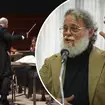Beethoven's Piano Music - Where To Start
Ludwig Van Beethoven's piano music is some of the most popular, and constantly played by performers everywhere. But if you're a first-time listener, where do you start?
Like much of Beethoven's work, his piano music can vary depending on when it was composed, what he was thinking about and, crucially, how grumpy he was. There's a fantastic range of moods to explore, from the light and humorous stuff to the dark and stormy struggles of a tormented soul… so brace yourself and get ready to experience Beethoven, the pianist.
The Sonatas
The bulk of Beethoven's piano music is contained in his sonatas. There re plenty of big-hitters here for you to get your teeth into, and the Moonlight Sonata (or the Piano Sonata no. 14) is as good a place as any to start. The first movement is constantly used in television and films to evoke mournful, doom-laden atmospheres, but there really is a lot more to it than that.
Once you've reminded yourself of the first movement, it's interesting to jump straight to the third, with its wild and stormy runs and manic soundworld. This is a million miles from the considered approach of the first movement and, quite neatly, shows exactly how varied Beethoven could make the piano sound. Remember what we said about Beethoven being grumpy? Well, this is positively ferocious stuff, probably best enjoyed with a stiff drink.
Once you've recovered, it's time to get ready for some more excitement. The Waldstein Sonata is just as exciting as the last movement of the Moonlight Sonata, but altogether more freewheeling and fun. The first movement is exhilarating - watch out for the hammering block chords and cheeky runs throughout - and definitely worth turning up loud. There are moments of sweetness and slowness in there as well, again showing just how expressive and varied the sonatas can be.
Concertos
There are plenty more sonatas that you can busy yourself with (more on those later), but in the meantime it's a good idea to look at Beethoven's work for piano and orchestra. If there are two things that Beethoven is known for, it's his symphonies and his solo piano work, so to combine them is pretty heavenly. In total he wrote just five concertos for the piano, but they're all pretty special in their own way.
The fifth piano concerto was written while Napoleon was bombarding Vienna. As we've established, Beethoven was an emotional man, but despite his very surroundings being blown to bits around him, he was able to keep a lid on it and compose this deeply rewarding concerto. It's usually referred to as the 'Emperor', presumably because of its standing in the piano world.
The Piano Concerto no. 3 is another good example. It's from earlier in Beethoven's life and isn't quite as epic, but it's full of great tunes and interesting developments. It's also worth noting that when Beethoven himself premiered the piece in 1803, it wasn't even finished. Instead of full sheet music, he relied on some scribbled notes on a page: quite brave, for a premiere. The second movement in particular shows what Beethoven could do when he slowed everything down.
And finally…
To finish on, we recommend a quick listen to Beethoven's last piano sonata, and one of the last works he ever composed for the piano. The Piano Sonata no. 32 only has two movements (the rulebook had pretty much been thrown out by this point), but both of them demonstrate again that huge range of emotion that Beethoven is able to produce. The opening of the first movement is moody, dark and slow, but doesn't take long to erupt into some more furious melodies. The second, by contrast, is frequently said to have prefigured jazz and ragtime with its inventive use of extremely quick notes.


























